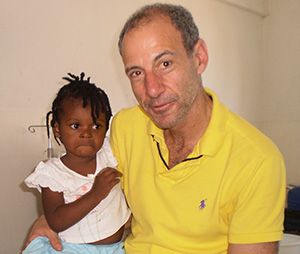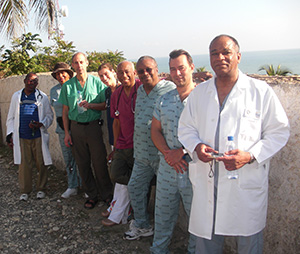

Offering A Helping Hand
A Tradition of Volunteering Begins with a Quake
The memory of the young girl clinging to him for comfort is one that stays with Dr. Paul Levin even now, nearly three years after the encounter. In the wake of the catastrophic earthquake that hit Haiti in 2010, Dr. Levin felt a tremor of his own – the desire to donate his medical skills to the devastated region.

Paul Levin, M.D. with a young patient"I had never volunteered overseas before," said the orthopaedic trauma surgeon who is associate professor of clinical orthopaedic surgery at Einstein and vice chair of orthopaedic surgery at Einstein's University Hospital, Montefiore Medical Center, where he also is director of the department's Moses Division. "Many of the survivors had suffered major musculoskeletal injuries, so there was a tremendous need for orthopaedic surgeons and trauma specialists. I had the needed skills and thought it would be a good idea to volunteer."
In the days following the disaster, he sought opportunities to take part in the relief effort. He explained, "The American Academy of Orthopaedic Surgeons and the Orthopaedic Trauma Association created a blog for orthopaedic surgeons who wanted to volunteer. After submitting your licensing and credentialing information, approved volunteers were directed to the blog link, which listed organizations and people who needed volunteers to go to Haiti with them."
In looking through the listing, Dr. Levin came across a phone number with a "631" area code, which he recognized as a Suffolk County number. "I called and I spoke with one of the physicians organizing the mission. The group consisted primarily of American physicians from Haiti. A number of the physicians were members of a church outside of Chicago with a Sister Parish in Sassier, a small city in Haiti. The church had an organization called Partners with Sassier that has been providing healthcare in Haiti for many years. They were organizing an emergency mission to the rural town of Jérémie, Haiti, to care for a huge influx of injured people who had evacuated Port-au-Prince and needed an orthopaedic surgeon."
Within a week, Dr. Levin joined the group on their mission to Haiti. They landed on a dirt runway in Jérémie.
"I'd never been to Haiti," he said. "The closest I'd been to that part of the world was when my wife and I have vacationed in the Caribbean islands; I'd never been exposed to a country with the level of poverty and economic need as Haiti. It was a sobering experience to see the extremely limited healthcare infrastructure and lack of the most basic medical supplies."
An Annual Ritual

The volunteer team representing Partners with SassierIn all, since 2010, Dr. Levin has made three volunteer trips to Haiti, and he plans to return again this year. During his most recent trip, he brought along extra luggage. "Because of the lack of basic medical supplies, last year I began bringing a suitcase full of casting material donated by my department This assures that the doctors we work with will have basic supplies for putting on casts," he noted.
On each of his trips, Dr. Levin has pitched in where needed, caring for individuals whose ailments ranged from pneumonia to post-traumatic stress disorder. "The first year, I was solely providing musculoskeletal medicine, caring for injuries specific to the earthquake. Since then, though, there's been much more need for basic medical care. My roles have included caring for patients who would normally be cared for by an emergency medicine physician, family physician, general surgeon, pediatrician or psychiatrist. You do what's needed."
Dr. Levin finds his work in Haiti extremely rewarding. "From the perspective of being a well-trained and well-experienced physician in the United States, we're extraordinarily lucky to have the resources that we do to take care of patients. Working in a nation like Haiti opens your eyes to that. And it's a truly invaluable endeavor to mentor healthcare providers who often must work with much less."
He continued, "The last two years, I've gone to a hospital in Port-au-Prince, and they want the American physicians to teach the Haitian physicians as well as take care of patients. We work with the local doctors on learning new skills and techniques that will aid their ability to provide the best possible care."
The experience has been educational for Dr. Levin, too. "We don't realize how good we have it in this country. Many American physicians never have the opportunity to learn that you can take excellent care of patients without the excessive use of healthcare services and testing that we commonly employ in the United States, often in wasteful ways."
He concluded, "I encourage others to volunteer, whether in Haiti or elsewhere. You'll meet people whose lives will touch you in memorable ways. And you'll help make a positive difference in the process. In retrospect, I'm sorry I waited so long to start doing it."
Photo Gallery
(To view slideshow of photo gallery, click on an image below; then move your mouse over the left or right margins to navigate.)
Posted on: Wednesday, April 17, 2013

















Tablet Blog